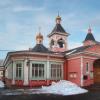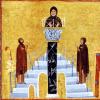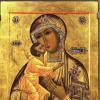Icon of the Tenderness of the Most Holy Theotokos of Diveyevo. Icon of the Mother of God of Tenderness. Rescue from pestilence
The shrine depicts the Reverend Virgin Mary experiencing the happiest moments of her life. The meeting with the Archangel Gabriel is over, and she knows that she will soon give birth to the baby Jesus. The icon of the Tenderness of the Most Holy Theotokos is distinguished by its solemn facial features and spiritual image. The defender is depicted with crossed arms, collected in a godly gesture, her head is slightly tilted, and her eyes are slightly covered with eyelids.
The appearance of the Mother of God speaks of her soft heart, chastity and humble behavior.
The history of the image of the Blessed Virgin Mary “Tenderness”
Initially, the shrine was made on canvas mounted on a cypress board. This image was especially revered by the monk Seraphim of Sarov, who knew how to see the soul of every person and ask for healing for everyone. He prayed before this face most often, with his hands raised to heaven. The saint lived a long life and ended his earthly journey in prayer before the image of the Protectress. Seraphim bequeathed this face to the Diveyevo temple, located not far from his monastery.
Interesting! Lamp oil burning near the image of the Virgin Mary acquired healing properties. Saint Seraphim often used this divine remedy to save many unfortunate people from various ailments.
Patriarch Alexei II of Moscow received the “Tenderness” in 1991. The Holy Image of the Mother of God was placed in the patriarchal monastery. Every year the image is brought for veneration to the Epiphany Cathedral, which can accommodate a large number of believers.
This day is considered a holiday: the clergy dress in appropriate clothes and perform a solemn service. On the days of December 22, August 1 and August 10, in monasteries you need to light candles in front of the Virgin Mary with a request for the health of loved ones, and also sing an akathist (praise choir). The icon of the Mother of God “Tenderness” is designed to instill meekness and spiritual humility in all parishioners.
“Tenderness” SERAFIMO-DIVEEVSKAYA
Varieties of the Holy Image
There is a large number of icons united under the general name “Tenderness”. The Mother of God is most often depicted in this manner.
In the traditional version, “Tenderness” shows the Holy Mother of God with the Baby Jesus in her arms, their cheeks pressed. The symbol explains the inseparable, boundless love and the absence of any distance between the Creator, His Son and His Mother.
The famous varieties of “Tenderness” include:
- Novgorodskaya. The production dates back to the end of the 12th century and is located in the Assumption Cathedral. The Mother and Christ, depicted in a pose typical of the Guide (Hodegetria), press their cheeks together. The baby holds a scroll in his right hand, and with his left he makes a gesture of blessing.
- The Pskov-Pecherskaya Icon is a copy of the Vladimir Icon, created in 1521 by the minister Arseny. The face is glorified by a large number of miraculous properties.
- Feodorovskaya. A revered image that is kept in the Epiphany Cathedral. This face is considered a shrine of the Romanov dynasty, because at the beginning of the 17th century. he called Mikhail Fedorovich, the founder of the dynasty, to reign.
- Donskaya. A double-sided icon, on the reverse side is the Dormition of the Virgin Mary - a holiday commemorating the death of the Mother of God. It was she who was presented to Dmitry Donskoy on the eve of the Battle of Kulikovo.
About the holidays in honor of the Mother of God:
In iconographic art there are other, less well-known images belonging to the “Tenderness” (Eleus) type.
 Feodorovskaya icon "Tenderness"
Feodorovskaya icon "Tenderness"
Seraphim-Diveyevo icon
The monk of Sarov called this image “The Joy of All Joys” because it brought healing to the sick people. The Virgin Mary repeatedly appeared before the eyes of the saint, curing him from a fatal illness. The original image has been preserved to this day, located in the Church of the Vladimir Icon.
The features of the image of the Virgin Mary clearly reflect her emotions at this moment: she waits with infinite patience and gratitude for the coming of the Son of the Lord. The Mother's eyes are humbly lowered, her hands are folded with a cross on her chest and symbolize the mystery of the Son's sacrifice. The icon painter decorated the face with few but expressive strokes, which allows one to see the essence of the exciting and solemn moment after the Annunciation.
On a note! Around the crown is inscribed the great phrase: “Hail, Unbridled Bride.” This means that humanity is ripe for the coming of its Savior.
The meaning and help of the holy image
The icon, for the most part, is considered the patroness of the female half of humanity.
- Girls pray to preserve their hearts in moral purity and innocence.
- The image is intended to improve everyday affairs.
- The Mother of God inspires confidence and strength in overcoming all sorts of worldly difficulties.
The Virgin Mary radiates divine humility and undying love, and her joyful face calms the mind filled with selfish malice at one glance. The Mother of God, by her example, teaches us to overcome despair and humbly lift the cross onto our shoulders. Sincere belief in the sanctity of the image brings relief and truly helps those in need.
- The Icon of the Mother of God “Tenderness” helps sick people get rid of misfortunes and pathologies.
- The Virgin Mary pacifies mental anger, dispels hateful thoughts and reduces the spread of mental disorders.
- The Protector has the power to influence the conception of girls who have not been able to get pregnant for a long time.
- Prayer restores the joy of life, completely driving away the depressive state of mind.
- Popular beliefs attribute the patronage of a worthy and successful marriage to the face.
Seraphim's Tenderness embodies sincere purity and restrained joy. This image of the Virgin Mary is considered the most sublime and mysterious, because there is no specific information about its appearance.
On a note! Some time after its creation, this shrine was the subject of humble and honest copying. Copies of this image, like the original, performed miracles in Christian circles.
 Icon "Tenderness"
Icon "Tenderness"
Miraculous achievements of the icon
Many divine accomplishments took place before the eyes of believers, proving the extraordinary power of the holy face. Orthodox Christianity attaches enormous importance to the icon of the Mother of God “Tenderness,” which reduces the negative impact of life-changing upheavals.
- According to the chronicle, in Novgorod in 1337 there was a merciless pestilence, claiming a huge number of victims. Desperate Orthodox people, having gathered together, made their way to the Trinity Cathedral, where they bitterly cried out for the image of the Virgin Mary. The clergy read prayers for the salvation of the unfortunate. A few days later, the severe infection subsided, and in gratitude for the redemption, the believers intended to make an annual religious procession to the image.
- In July of the same year, the icon of “Tenderness” streamed myrrh, and the canvas floated in the air, held in space by an irresistible force. The assembled clergy regarded this occasion as a call to timely services.
- In the house of a couple from the Bryansk region there is a shrine that saved a visiting woman from cancer. On the day of surgery, an ultrasound did not show any malignant changes in the patient’s cells. The healing took place in an amazing way after a sincere request for help from the Protector.
- The history of the modern icon of the Mother of God “Seraphim Tenderness” is amazing. One woman saw an image of the Mother of God on an expired and unsaleable calendar in a church shop and took it into her own home with a feeling of deepest concern. After a while, the holy face began to stream myrrh, and with it all the other iconography in the dwelling. On the reverse side, another appearance formed. From now on, the woman hosts believing pilgrims.
More about miraculous phenomena:
Shrine locations
The original, presented by Nicholas II, is located in the Cathedral of St. Seraphim of Sarov, in Golitsyno. This image was painted in the 19th century. For over 40 years it was in the home of the icon painter who created it. The image of the Mother of God was transferred to the monastery at the first news of the beginning of construction.
One of the most revered images of the Virgin Mary is kept in the Trinity Monastery. The significance of the “Tenderness” icon of the Mother of God is difficult to overestimate for the Russian people. The shrine, famous for its colossal number of miracles, was painted by the nuns of this monastery at the end of the 20th century. Every Sunday, church hymns are held in front of the shrine.
Hymns in honor of the Protectress
In church practice, a sufficient number of prayers dedicated to the Mother of God are known. Orthodox Christians praise the Most Holy Mother, calling her the Great Intercessor and the Glory of our Motherland. People standing before the face of the Tenderness icon pray to save themselves and their loved ones from the invasion of evil forces, enemies of the people, earthquakes and many similar disasters.
Advice! Any prayer pronounced with a clear conscience gives a great chance of fulfilling pious desires.
The akathists to the Mother of God contain a laudatory theme, highlighting some historical facts of the glorification of the holy face. The choirs present various requests for the protection of the sinful human race. The end of the akathist is marked by a kneeling petition in the name of the health of all humanity.
Important! The Orthodox world knows many icons of the “Tenderness” variety. Each of them is capable of exerting a miraculous effect on surrounding objects and the person asking. They pray to the Most Holy Mother in any misfortune and torment. She humbly listens to those who come and invariably brings good to true Christians.
Watch the video about the icon of the Mother of God
Icon of the Mother of God “Tenderness” (SERAPHIM - DIVEEVSKAYA)
_____________________________________________________
The icon of the Mother of God was a cell image. With oil from the lamp that burned in front of the cell icon, the Monk Seraphim anointed the sick, and they received healing. In front of this icon, the monk departed to the Lord. Another name for the icon is “The Joy of All Joys.” This is what Saint Seraphim himself often called the icon of TOUCHING.
After the glorification of St. Seraphim as a saint, Emperor Nicholas II presented a precious robe for the icon of Tenderness. In 1927, the Diveyevo Monastery, where the original “Joy of All Joys” icon was located, was closed, but the holy image was secretly removed. For decades it was kept by pious people. In June 1991, the icon was handed over to Patriarch Alexy II, and now it is in the Patriarchal residence. Once a year, on the Feast of the Praise of the Most Holy Theotokos, the Seraphim-Diveyevo Icon of Tenderness is brought to the Patriarchal Epiphany Cathedral for public veneration.

_______________________________________________________
Veneration of the icon Tenderness is associated with the name of St. Seraphim of Sarov (P.I. Moshnin, 1759-1833, canonized in 1903). According to the biography, compiled from the memoirs of people who knew the Sarov elder closely, his entire life passed under the patronage of the Mother of God. The Mother of God repeatedly appeared to him in visions and healed him from deadly diseases. At Rev. Seraphim had several icons of the Mother of God. Among them, a special place was occupied by the cell icon called Tenderness, which the elder also called “The Joy of All Joys.” Before her, kneeling in prayer, he died. The icon was painted on canvas stretched over a cypress board. After the death of Rev. Seraphim, abbot Nifont transferred the image to the nearby Diveevo convent, which was under the patronage of Elder Seraphim. In Diveyevo a silver gilded robe was made for the icon. Here in the Cathedral of the Holy Trinity a special chapel was built for the icon, dedicated to its name - the Tenderness of the Mother of God. The icon was celebrated on July 28 and December 9 (the founding day of the monastery). Metropolitan Seraphim (Chichagov) composed a special service for the illustrious icon. To the discovery of the relics of St. A copy of Seraphim from the icon was made for the Sarov Monastery. After the canonization, the production of lists began in the icon-painting workshops of the Diveyevo Monastery and its courtyard in Peterhof. The icon was depicted in various printed publications and in hagiographic images of St. Seraphim.
The icon from the Tretyakov Gallery is an exact copy of the revered image. The image of the Mother of God is half-length, with her hands folded on her chest, her head bowed and her gaze downcast. Western iconography, which appeared in Russia in the 17th century. On the copy icon, the gilded frame and chasuble, ubrus and crown, decorated with precious stones, are imitated by means of painting. The faces of the hand are executed with soft chiaroscuro modeling in the style of academic painting of the early 20th century, used for painting icons. The crown is framed by the inscription: “Rejoice, unbrided bride.”

____________________________________________
Also read on our website:
The first Orthodox radio in the FM range!
You can listen in the car, at the dacha, wherever you do not have access to Orthodox literature or other materials.
_____________________________________________________
The icon was a cell image. With oil from the lamp that burned in front of the cell icon, the Monk Seraphim anointed the sick, and they received healing. In front of this icon, the monk departed to the Lord. Another name for the icon is “The Joy of All Joys.” This is what Saint Seraphim himself often called the icon of TOUCHING.
After being glorified as a saint, Emperor Nicholas II presented a precious robe for the Tenderness icon. In 1927, the Diveyevo Monastery, where the original “Joy of All Joys” icon was located, was closed, but the holy image was secretly removed. For decades it was kept by pious people. In June 1991, the icon was handed over to Patriarch Alexy II, and now it is in the Patriarchal residence. Once a year, on the Feast of the Praise of the Most Holy Theotokos, the Seraphim-Diveyevo Icon of Tenderness is brought to the Patriarchal Epiphany Cathedral for public veneration.

_______________________________________________________
Veneration of the icon Tenderness is associated with the name of St. Seraphim of Sarov (P.I. Moshnin, 1759-1833, canonized in 1903). According to the biography, compiled from the memoirs of people who knew the Sarov elder closely, his entire life passed under the patronage of the Mother of God. The Mother of God repeatedly appeared to him in visions and healed him from deadly diseases. At Rev. Seraphim had several icons of the Mother of God. Among them, a special place was occupied by the cell icon called Tenderness, which the elder also called “The Joy of All Joys.” Before her, kneeling in prayer, he died. The icon was painted on canvas stretched over a cypress board. After the death of Rev. Seraphim, abbot Nifont transferred the image to the nearby Diveyevo convent, which was under the patronage. In Diveyevo a silver gilded robe was made for the icon. Here in the Cathedral of the Holy Trinity a special chapel was built for the icon, dedicated to its name - the Tenderness of the Mother of God. The icon was celebrated on July 28 and December 9 (the founding day of the monastery). Metropolitan Seraphim (Chichagov) composed a special service for the illustrious icon. To the discovery of the relics of St. A copy of Seraphim from the icon was made for the Sarov Monastery. After the canonization, the production of lists began in the icon-painting workshops of the Diveyevo Monastery and its courtyard in Peterhof. The icon was depicted in various printed publications and in hagiographic images of St. Seraphim.
The icon from the Tretyakov Gallery is an exact copy of the revered image. The image of the Mother of God is half-length, with her hands folded on her chest, her head bowed and her gaze downcast. Western iconography, which appeared in Russia in the 17th century. On the copy icon, the gilded frame and chasuble, ubrus and crown, decorated with precious stones, are imitated by means of painting. The faces of the hand are executed with soft chiaroscuro modeling in the style of academic painting of the early 20th century, used for painting icons. The crown is framed by the inscription: “Rejoice, unbrided bride.”

____________________________________________
Also read on our website:
Earthly life of the Virgin Mary- Description of the life, Christmas, Dormition of the Mother of God.
Apparitions of the Virgin Mary- About the miraculous apparitions of the Mother of God.
Icons of the Mother of God- Information about the types of icon painting, descriptions of most icons of the Mother of God.
Prayers to the Mother of God- Basic prayers. - Description of some superstitions.
__________________________________________________
http://pravkurs.ru/ - Orthodox online distance learning course. We recommend taking this course to all beginning Orthodox Christians. Online training takes place twice a year. sign up for the following courses today
In the Orthodox Church, several types of icons of the Mother of God “Tenderness” (in the Greek tradition - “Eleusa”) are accepted for veneration. Eleusa (Greek Ελεούσα - merciful from έλεος - compassion, sympathy) is one of the main types of depiction of the Mother of God in Russian icon painting. On them, the Most Holy Theotokos is usually depicted from the waist up and holding the baby - the Savior - in her arms and bowing with tenderness to her Divine Son.
The Seraphim-Diveyevo icon “Tenderness” is different from the others - the Mother of God is depicted alone on it. An interesting fact is that the iconographic type of this icon is characteristic of Western Christianity rather than the Eastern tradition of writing. In iconography, it goes back to the Ostrobramskaya Icon of the Mother of God, revered in Lithuania and western Russia, from which it differs in the absence of Western attributes - a crescent moon at the bottom and stars around the halo. The Most Holy Theotokos is depicted here at a young age, at that moment in Her life when Archangel Gabriel announced the Good News about the incarnation of the Son of God. The face of the Holy Virgin Mary is thoughtful, her hands are folded crosswise on her chest, her gaze is turned down, her eyes are half-closed, and her whole appearance conveys a state of deep humility and love. Above the head there is an inscription of words from the akathist: “Rejoice, Unbrideless Bride!” This image does not belong to the “Eleusa” type of icon painting, however, it has an identical name.

The Seraphim-Diveyevo Icon of the Mother of God “Tenderness” belonged to the Venerable Seraphim of Sarov and was his cell icon. The history of writing and the author of this icon are unknown; its origin dates back to the end of the 18th century.

With oil from the lamp that burned in front of this holy icon, the Reverend anointed the sick, who received healing after the anointing.

The ascetic called the icon “Tenderness” - “Joy of All Joys”, and in front of it he died in prayer on January 2, 1833. After the death of St. Seraphim, the Sarov rector, Fr. Nifont gave the holy icon “Joy of All Joys” to the sisters of the Diveyevo Seraphim Monastery. They moved it to the Holy Trinity Cathedral of the Diveyevo monastery, where the icon was located until the Soviet period. For this purpose, a special chapel was built, and the icon was placed in a special elegant icon case. Since those times, there has been a tradition: all nuns of the monastery stand behind the icon case of the Mother of God during the service.
In 1902, Saint Emperor Nicholas II presented the monastery with a precious gilded robe for the Tenderness icon and a decorated silver lamp. In the year when Seraphim of Sarov was glorified, several accurate copies were made from the icon of the Mother of God, which were sent to various Russian monasteries.
In 1927 The Diveyevo Monastery, where the original “Joy of all Joys” icon was located, was closed, but the holy image was secretly taken to Murom by Abbess Alexandra of Diveyevo. For decades it was kept by pious people.
In 1991 the miraculous image was handed over to the Patriarch of Moscow and All Rus' Alexy II, who placed the icon in the Patriarchal Church of the Vladimir Icon of the Mother of God of the working Patriarchal residence in Chisty Lane, where she is currently located.
According to tradition, once a year - on the Feast of the Praise of the Blessed Virgin Mary (5th Sunday of Great Lent (Saturday of the Akathist)) - the Primate of the Russian Orthodox Church brings the Seraphim-Diveyevo Icon of the Mother of God “Tenderness” to the service in Moscow Epiphany Cathedral in Elokhov to read the Akathist before her. On this day, the miraculous image is brought out for veneration - all Orthodox Christians who wish can venerate it.

The Diveyesky Monastery now houses an exact copy of the miraculous image., which is considered one of the main shrines of the Seraphim-Diveevo Monastery. The nuns and nuns of the convent consider her their Heavenly Mother Superior.

The celebration of the Seraphim-Diveyevo Icon “Tenderness” is taking place July 28/August 10.
Prayer before the icon of the Mother of God “Tenderness” Pskov-Pecherskaya
O Most Holy Lady Lady, Virgin Mary! Accept our unworthy prayers, save us from the slander of evil people and from vain death, grant us repentance before the end, have mercy on our prayers and grant joy in sorrow a place. And deliver us, O Lady Lady Theotokos, from every misfortune, adversity, sorrow, illness and all evil, and vouchsafe us, Thy sinful servants, to the right hand at the second coming of Thy Son, Christ our God, and make us heirs to be vouchsafed the Kingdom of Heaven and eternal life with all the saints for ever and ever. Amen.
In the Orthodox Church, several types of icons of the Mother of God “Tenderness” (in the Greek tradition - “Eleusa”) are accepted for veneration. Eleusa (Greek Ελεούσα - merciful from έλεος - compassion, sympathy) is one of the main types of depiction of the Mother of God in Russian icon painting. On them, the Most Holy Theotokos is usually depicted from the waist up and holding the baby - the Savior - in her arms and bowing with tenderness to her Divine Son.
The Seraphim-Diveyevo icon “Tenderness” is different from the others - the Mother of God is depicted alone on it. An interesting fact is that the iconographic type of this icon is characteristic of Western Christianity rather than the Eastern tradition of writing. In iconography, it goes back to the Ostrobramskaya Icon of the Mother of God, revered in Lithuania and western Russia, from which it differs in the absence of Western attributes - a crescent moon at the bottom and stars around the halo. The Most Holy Theotokos is depicted here at a young age, at that moment in Her life when Archangel Gabriel announced the Good News about the incarnation of the Son of God. The face of the Holy Virgin Mary is thoughtful, her hands are folded crosswise on her chest, her gaze is turned down, her eyes are half-closed, and her whole appearance conveys a state of deep humility and love. Above the head there is an inscription of words from the akathist: “Rejoice, Unbrideless Bride!” This image does not belong to the “Eleusa” type of icon painting, however, it has an identical name.
The Seraphim-Diveyevo Icon of the Mother of God “Tenderness” belonged to the Venerable Seraphim of Sarov and was his cell icon. The history of writing and the author of this icon are unknown; its origin dates back to the end of the 18th century.
With oil from the lamp that burned in front of this holy icon, the Reverend anointed the sick, who received healing after the anointing.
The ascetic called the icon “Tenderness” - “Joy of All Joys”, and in front of it he died in prayer on January 2, 1833. After the death of St. Seraphim, the Sarov rector, Fr. Nifont gave the holy icon “Joy of All Joys” to the sisters of the Diveyevo Seraphim Monastery. They moved it to the Holy Trinity Cathedral of the Diveyevo monastery, where the icon was located until the Soviet period. For this purpose, a special chapel was built, and the icon was placed in a special elegant icon case. Since those times, there has been a tradition: all nuns of the monastery stand behind the icon case of the Mother of God during the service.
In 1902, Saint Emperor Nicholas II presented the monastery with a precious gilded robe for the Tenderness icon and a decorated silver lamp. In the year when Seraphim of Sarov was glorified, several accurate copies were made from the icon of the Mother of God, which were sent to various Russian monasteries.
In 1927 The Diveyevo Monastery, where the original “Joy of all Joys” icon was located, was closed, but the holy image was secretly taken to Murom by Abbess Alexandra of Diveyevo. For decades it was kept by pious people.
In 1991 the miraculous image was handed over to the Patriarch of Moscow and All Rus' Alexy II, who placed the icon in the Patriarchal Church of the Vladimir Icon of the Mother of God of the working Patriarchal residence in Chisty Lane, where she is currently located.
According to tradition, once a year - on the Feast of the Praise of the Blessed Virgin Mary (5th Sunday of Great Lent (Saturday of the Akathist)) - the Primate of the Russian Orthodox Church brings the Seraphim-Diveyevo Icon of the Mother of God “Tenderness” to the service in Moscow Epiphany Cathedral in Elokhov to read the Akathist before her. On this day, the miraculous image is brought out for veneration - all Orthodox Christians who wish can venerate it.
The Diveyesky Monastery now houses an exact copy of the miraculous image., which is considered one of the main shrines of the Seraphim-Diveevo Monastery. The nuns and nuns of the convent consider her their Heavenly Mother Superior.
Prayer before the icon of the Mother of God “Tenderness” Pskov-Pecherskaya
O Most Holy Lady Lady, Virgin Mary! Accept our unworthy prayers, save us from the slander of evil people and from vain death, grant us repentance before the end, have mercy on our prayers and grant joy in sorrow a place. And deliver us, O Lady Lady Theotokos, from every misfortune, adversity, sorrow, illness and all evil, and vouchsafe us, Thy sinful servants, to the right hand at the second coming of Thy Son, Christ our God, and make us heirs to be vouchsafed the Kingdom of Heaven and eternal life with all the saints for ever and ever. Amen.



















